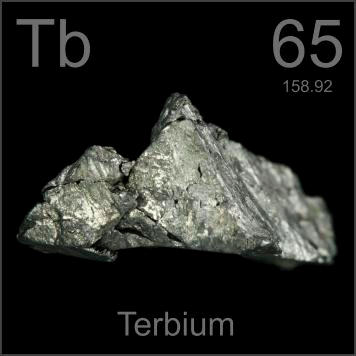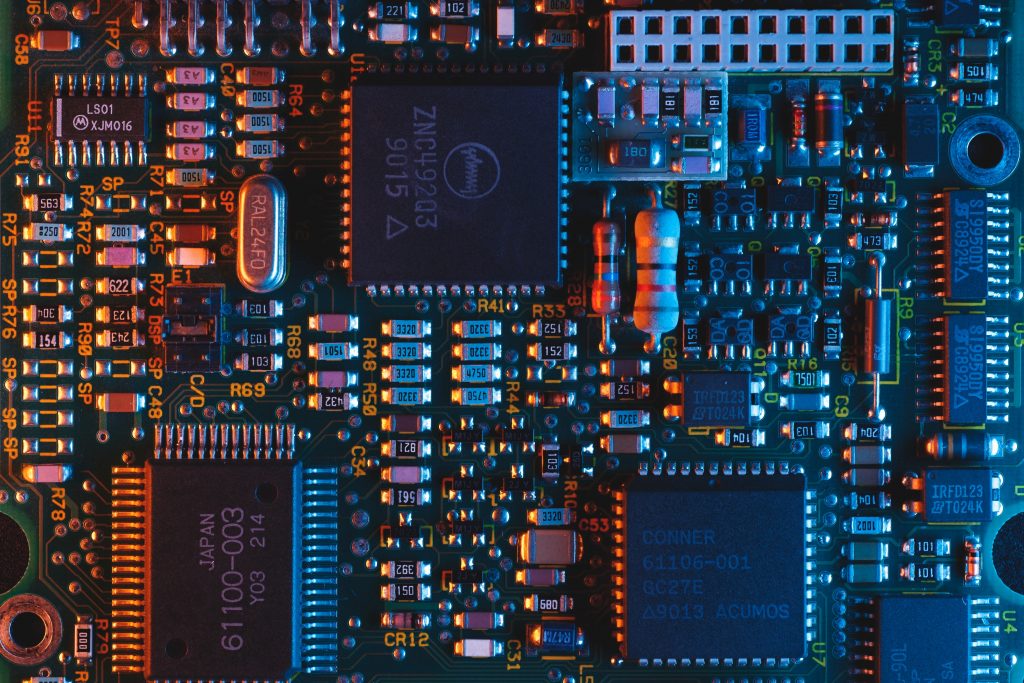Rare Earth Terbium – Description
Terbium, the 65th element of the periodic table, is a rare earth metal belonging to the lanthanide series. Although the lanthanides have been described as a boring group of elements, each of them has its own unique properties and uses. Terbium, though not as popular as Neodymium, Ytterbium, or Samarium, still has important applications and it is twice as common as silver in the Earth’s crust. A notable application of terbium is in the production of Terfenol-D, an alloy of terbium, which is used in actuators.
Further Reading: Seventeen Rare Earth Elements Introduction
The element lies in the middle of the lanthanide series between gadolinium and dysprosium. Compounds of terbium generally contain the terbium ion in its 3+ valence state. But in some solid compounds, terbium can exist in the 4+ valence state, which is quite unusual. This is because its fourth ionization energy is relatively low and it attains a more stable half-filled outermost shell of electrons. Another striking property of terbium compounds can be traced to their spectroscopic and optical properties, making it one of the more exciting and studied lanthanide elements.

Discovery of Rare Earth Terbium
The Swedish chemist Carl Gustaf Mosander was the first to successfully isolate terbium in 1843 in Stockholm. Mosander had already investigated cerium oxide and separated a new element, lanthanum from it. He then later focused on yttrium, thinking that it might also be containing another element. He later successfully isolated two metal oxides from yttrium, namely; terbium oxide and erbium oxide, which he announced in 1843. Terbium oxide is yellow in color and erbium oxide has a rose pink color.
In 1843, Professor Carl Mosander was able to separate the gadolinite mineral into three materials, which he called yttria, erbia, and terbia. From two of these substances, he discovered erbium and terbium.
Occurrence/Sources of Rare Earth Terbium
Terbium can be found in minerals along with other rare-earth elements, including cerite and gadolinite. The element can be extracted from monazite, which contains up to 0.03 percent of the element. It can also be obtained from euxenite, a complex oxide containing about one percent of terbia. Another source is xenotime. With recent advances in ion-exchange techniques for separating rare earth elements, terbium can be easily isolated from its natural sources. This is the most efficient separation routine for terbium salt from the rare-earth salt solution.
One method for producing rare-earth metals commercially is by reducing the anhydrous chloride or fluoride with calcium, although other methods of isolation are available. Vacuum remelting can be used to remove calcium and tantalum impurities. It is also possible to produce terbium by the electrolysis of terbium oxide in molten calcium chloride.
Properties of Rare Earth Terbium
- Terbium is a rare-earth metal belonging to the lanthanide series.
- The 9th element of the lanthanide series
- It is a fairly electropositive metal that reacts with water, evolving hydrogen gas.
- The metal is soft and silver-gray metal in color and is relatively stable in air.
- It is malleable and can be cut with a knife.
- It occurs in two crystal modifications, with a transformation temperature of 2,352 °F (1,289 °C).
- It forms an oxide with a dark maroon or chocolate color.
- Terbium has several isotopes with atomic masses ranging from 145 to 165.
- Not much is known about the toxicity of terbium, suggesting that it should be handled with care.
Isotopes of Rare Earth Terbium
Several isotopes of terbium have been characterized. But naturally occurring terbium has only a stable isotope, terbium-159. It is mononucleosis and monoisotopic. Currently, 36 radioactive isotopes of terbium have been characterized, with the heaviest being terbium-171 and the lightest being terbium-135. Of all the radioisotopes, the most stable are terbium-158 (half-life of 180 years) and terbium-157 (half-life of 71 years).
Terbium also has 27 nuclear isomers, with masses of 141–154, 156, and 158, with the most stable being terbium-156m, having a half-life of 24.4 hours, and terbium-156m2, with a half-life of 22.7 hours.

Uses of Rare Earth Terbium
Like other rare-earth metals, terbium has unique applications, though there are not many of them.
- Sodium terbium borate is used in solid-state devices. When combined with zirconium dioxide, sodium terbium can act as a crystal stabilizer of elevated-temperature fuel cells.
- Terbium sputtering targets and terbium evaporation materials are used in deposition processes including semiconductor deposition, chemical vapor deposition (CVD), and physical vapor deposition (PVD).
- Terbium is also used as a dopant in calcium fluoride, calcium tungstate, strontium molybdate, and materials used in solid-state devices.
- Terbium is used to make alloys and electronic devices.
- Terbium is used in actuators, as a component of Terfenol-D, a terbium alloy that expands or contracts in the presence of a magnetic field.
- It is also used in naval sonar systems, sensors, and other magneto-mechanical devices.
- Terbium salts find useful applications in laser devices.
Conclusion
If you want to know more about rare earth coating materials, we would like to advise you to visit Stanford Advanced Materials (SAM) for more information.




